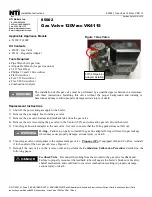
15
ACTIVATED CARBON
Activated carbon is prepared in a manner which causes
the carbon crystals to become porous and develop
a very large surface area. One gram of activated
carbon may have 500–1,500 m2 (5,382-16,146 ft2) of
internal surface area. This large surface area and the
many internal pores in the carbon are able to adsorb
many different chemical compounds including those
which cause unwanted flavours in your spirit. The
adsorption process is very complex and depends on
concentrations, molecular weight etc.
It can be added directly in your wash, or used for
filtering the distillate. In the case of alcoholic spirit
the process works best if the alcohol concentration is
50% or less. This is why we recommend adjusting the
alcohol level before purification. Activated carbon must
be soaked or rinsed with clean water just before using
to get rid of mineral salts and dust.
ALCOHOL (OR ETHANOL)
Most commonly used to describe ethanol, the type
of alcohol in wine, beer, spirits and other alcoholic
beverages. It is a chemical with the formula C2H5OH.
ALCOHOL PURITY
Alcohol purity describes the strength of the alcohol
produced by distillation; it is measured in percentage of
alcohol by volume, or % ABV. The Turbo 500 Distillation
System delivers 90 to 93% ABV alcohol, when following
the recipes and set up described in this booklet.
ALCOHOL YIELD
Alcohol yield describes the effectiveness of alcohol
extraction from the wash. The higher the yield the
less alcohol is left behind in the boiler. With care and
attention to wash clearing and the distillation process,
you can expect to recover 95% or more of the alcohol
fermented in the wash.
The purity and yield of the alcohol will vary depending
on factors such as;
•
The type of sugar you ferment
•
The choice of yeast used
•
How well the wash is cleared
•
What distillation system is used
ALCOMETER & HYDROMETER
An Alcometer is one type of hydrometer. Hydrometers
are used to measure the relative density of a liquid.
The lighter the liquid the further down the hydrometer
floats.
The hydrometer is used to monitor wash fermentation,
it tells how much sugar has been transformed into
alcohol (alcohol is lighter than a sugar solution).
Alcometers are used to measure the percentage of
alcohol in your spirit. Alcohol is thinner than water so
the higher in strength the alcohol is, the further down
the hydrometer sinks. Additives such as flavouring and
liquid glucose will distort the alcoholmeter readings.
Take good care of your hydrometer as it is very fragile.
Hydrometers are usually calibrated at a temperature of
20°C (68°F).
Do not immerse your hydrometer in liquids warmer
than 40°C (104°F) or it will melt the wax inside and
damage your hydrometer irreversibly.
CONGENERS
The name given to all compounds in the distillate,
other than water and alcohol.
DISTILLATE
The concentrated liquid that condenses from a
distillation process.
DISTILLATION
Method of separating two or more substances by
heating the mixture to a temperature that is higher
than the boiling point of one component and lower
than the boiling point of the other component.
The vapour of the lower boiling point component
is captured and allowed to condense and is more
concentrated compared to the original mixture.
FERMENTATION
Conversion of carbohydrates (sugars) into alcohol and
carbon dioxide by yeast.
HEADS
The name given to the first portion of distillate
collected. They are composed of congeners which have
a distinctive smell (‘fruity’, ‘nail polish’).
METHANOL
An alcohol naturally produced during fermentation at
very low level (0.0005%). Its chemical formula is CH3OH.
Effects of methanol ingestion at high levels (0.5% and
over), may include confusion, nausea, vomiting, visual
problems and abdominal pain which if left untreated
can result in stupor, coma and in the most severe
cases death.
Problems occur across a broad range of countries,
most prominent with common illegal trade where
methanol has been added or the alcohol has been
produced from unsuitable carbohydrate raw material.
The Turbo 500 Distillation System produces a highly
pure spirit with 0.001% methanol on average, which
is well below the maximum legal limits for methanol
into spirits. It is worth noting that ethanol is used to
dislodge methanol in the case of methanol poisoning as
human cells will dislodge methanol in preference
to ethanol.
SPIRIT
An alcohol beverage containing at least 20% ABV and
with no added sugar.
TAILS
The name given to the last portion of distillate
collected when using a pot still. They are composed
of congeners, responsible for burnt ‘off’ flavours. The
Turbo 500 Distillation System doesn’t produce tails.
WASH
Fermented liquid containing alcohol which has been
produced by yeast fermenting sugars.
YEASTS
Yeasts are microorganisms that convert sugar to
produce alcohol and CO2 along with hundreds of trace
by-products.
GLOSSARY


































